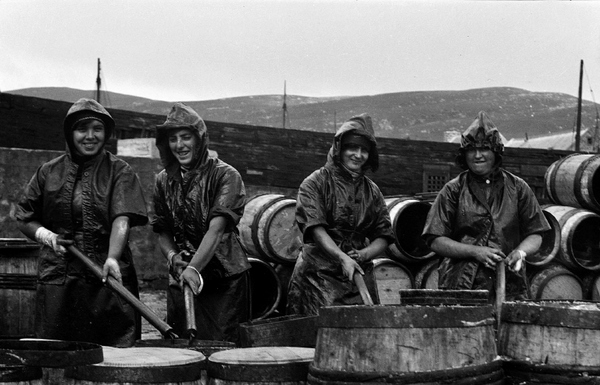Guddicks: Make do and mend
There was seemingly no end to the way in which worn textiles were used to repair or even make new clothing in Shetland. The chapter ‘Sacks, smucks & sokkaleggs’ in Amy Lightfoot and Laurie Goodlad’s book, Guddicks, describes the ingenious ways in which materials were recycled and put to good use in the fishing industry.
In Shetland knitted and woven woollen garments, hessian sacks and flour bags made of cotton were all recycled, sometimes several times and for a multitude of purposes.
Old flour bags were used for the haddock “that was stored upstairs at the back of the lining, so in the winter when they couldn’t win [get] off to the fishing, we had salt dried fish.” [Mary Ann Anderson]
Fishermen’s underwear was still hand knitted of swaara (soft, handspun, woollen yarn for knitting underwear) even after mill spun yarns became available, because older fishermen complained that the mill yarns were spun from coarser wool that scratched: “I remember makkin [knitting] that [fishermen’s underwear] from white, grey or moorit, homespun wirsit [homespun woollen yarn]. On top of that they had cotton overalls and that was when the flour bags came in. Over their woollen things they had overalls tied with a string below the knee [to keep the socks up]”. [Mary Manson]
Even the ‘herring lassies’ (women gutters who followed the British fishing fleets from the 19th century until the 1960s) made use of cotton flour bags. “Gutting with sharp knives inevitably resulted in painful cuts and sores, which were constantly aggravated by contact with the salt. The women protected their fingers with ‘clooties/clotts’, crude bandages made from old rags and cotton flour sacks bought cheaply from bakers.”
Information taken from Guddicks, Traditional Riddles from Shetland by Amy Lightfoot and Laurie Goodlad. The book is available to buy from The Shetland Times bookshop for £24.99.
Pictures kindly reproduced with permission from the Shetland Museum and Archives.

